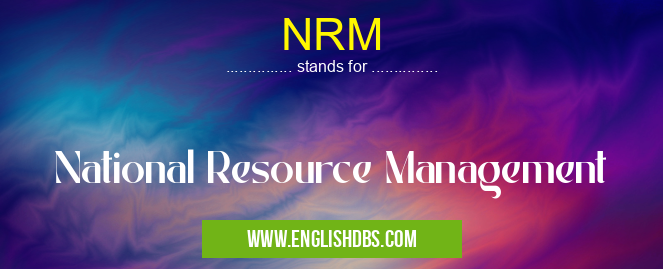What does NRM mean in MANAGEMENT
National Resource Management (NRM) is a broad field that encompasses multiple approaches to the sustainable use and preservation of natural resources within a country's borders. It deals with issues such as managing land and water resources, protecting endangered species and preserving ecosystems for future generations. NRM also involves finding ways to reduce waste and mitigate impacts from human activities on the environment. By ensuring responsible management of natural resources, NRM can help to promote economic stability and protection from climate change. NRM is an all-encompassing, integrated system of policies and practices intended to ensure the long-term sustainability of both people and the environment.

NRM meaning in Management in Business
NRM mostly used in an acronym Management in Category Business that means National Resource Management
Shorthand: NRM,
Full Form: National Resource Management
For more information of "National Resource Management", see the section below.
» Business » Management
Benefits Of National Resource Management
The benefits of using National Resource Management principles extend far beyond simply preserving natural reserves or conserving energy sources; it helps in promoting social welfare by providing access to essential resources for communities who are unable to afford them otherwise. When managed responsibly, resources can be sustainably used for years without depleting them - this ensures that everyone has access regardless of income level or locality. Additionally, through efficient management methods such as waste reduction initiatives, emissions control standards and renewable energy programs, NRM helps countries adapt better to climate change while preventing severe damage from occurring in its wake.
Essential Questions and Answers on National Resource Management in "BUSINESS»MANAGEMENT"
What is National Resource Management?
National Resource Management (NRM) is a comprehensive approach to environmental management focused on the sustainable use and protection of resources. It incorporates a combination of scientific, regulatory, economic, social, and cultural elements to ensure the long-term health of natural resources. NRM includes activities like watershed management, climate change adaptation, conservation planning, and land restoration.
How does NRM protect natural resources?
NRM promotes sustainability and stewardship by managing natural resources in ways that minimize their depletion over time. This means protecting existing resources from degradation or harm as well as conserving them for future generations. NRM also works to restore any damaged habitats or ecosystems through activities like planting native species and restoring wetlands.
What are the benefits of NRM?
There are numerous environmental and economic benefits associated with practicing good resource management. These include improved water quality, reduced erosion and sedimentation, increased biodiversity, enhanced wildlife habitat, improved landscape aesthetics, increased recreational opportunities, increased safety for aquatic life, better air quality, reduced flooding potential and decreased risk from pollution or other human activities. Proper implementation can also result in cost savings over time due to better land use practices that reduce maintenance demands.
What role does science play in NRM?
Science plays a critical role in assessing the state of natural resources in order to identify potential threats or problems before they become unmanageable. Scientific research techniques are used to collect data about an area such as soil composition and water chemistry which can help inform decision making regarding how best to manage the environment effectively while maintaining healthy ecosystems and habitats.
What are some common tools used in NRM?
Common tools used in Natural Resource Management include Geographic Information Systems (GIS) which allow map makers to create accurate maps of an area; Remote Sensing Technology which allows scientists observe changes across vast areas without physically observing it; Hydrologic Models which quantify how much water flows through an area; Air Quality Monitoring that measures air pollution levels; Climate Change models for tracking temperatures patterns over time; Fire Risk Assessment Tools for predicting wildfire spread; Floodplain Mapping Tools for identifying potential inundated areas due to floods or heavy rains.
Who is responsible for implementing NRM?
Many different stakeholders including governments agencies at all levels (local/state/federal), non-profits organizations concerned with sustainability issues, private companies, universities and research institutions all have a role to play when it comes to implementing effective Natural Resource Management programs. All stakeholders must work together collaboratively towards common goals such as protecting existing ecosystems while promoting responsible stewardship.
What challenges do we face when implementing NRM?
We need to be aware of competing interests due to increasing pressure on limited resources from population growth demands - especially when regulating industries with large environmental footprint such as mining or energy production. When developing plans, account must be taken into consideration of cultural values attached certain type of land uses whether it's recreational or commercial. Additionally, finding funding sources for projects can be challenging.
Final Words:
National Resource Management is an essential component for any developing country looking for ways to build up its economy without compromising environmental integrity or social justice measures in the process. Managing national resources properly requires sound policymaking along with appropriate legislation governing resource use and conservation efforts - this way citizens have access while environments remain undamaged by unsustainable harvesting practices or pollution buildup over time. Ultimately, NRM serves as an invaluable tool when it comes to achieving real sustainability goals both now and well into the future.
